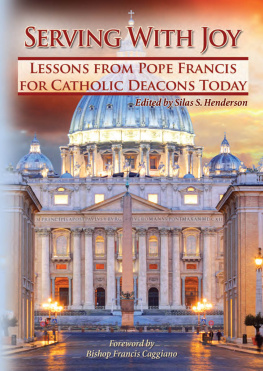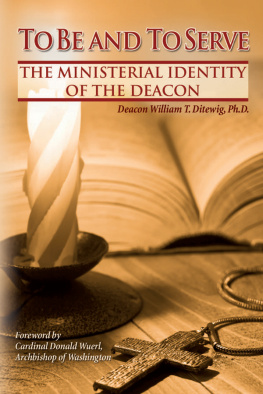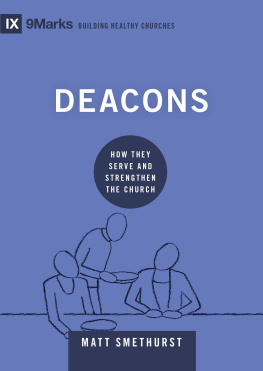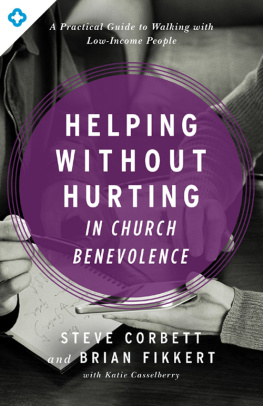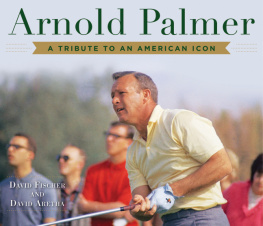William T. Ditewig - 101 Questions and Answers on Deacons
Here you can read online William T. Ditewig - 101 Questions and Answers on Deacons full text of the book (entire story) in english for free. Download pdf and epub, get meaning, cover and reviews about this ebook. year: 2014, publisher: Paulist Press, genre: Religion. Description of the work, (preface) as well as reviews are available. Best literature library LitArk.com created for fans of good reading and offers a wide selection of genres:
Romance novel
Science fiction
Adventure
Detective
Science
History
Home and family
Prose
Art
Politics
Computer
Non-fiction
Religion
Business
Children
Humor
Choose a favorite category and find really read worthwhile books. Enjoy immersion in the world of imagination, feel the emotions of the characters or learn something new for yourself, make an fascinating discovery.

- Book:101 Questions and Answers on Deacons
- Author:
- Publisher:Paulist Press
- Genre:
- Year:2014
- Rating:4 / 5
- Favourites:Add to favourites
- Your mark:
- 80
- 1
- 2
- 3
- 4
- 5
101 Questions and Answers on Deacons: summary, description and annotation
We offer to read an annotation, description, summary or preface (depends on what the author of the book "101 Questions and Answers on Deacons" wrote himself). If you haven't found the necessary information about the book — write in the comments, we will try to find it.
101 Questions and Answers on Deacons — read online for free the complete book (whole text) full work
Below is the text of the book, divided by pages. System saving the place of the last page read, allows you to conveniently read the book "101 Questions and Answers on Deacons" online for free, without having to search again every time where you left off. Put a bookmark, and you can go to the page where you finished reading at any time.
Font size:
Interval:
Bookmark:
101 Questions and Answers on Deacons
William T. Ditewig

Paulist Press
New York/Mahwah, N.J.
Nihil Obstat:
Rev. Isidore Dixon
Censor Deputatus
Imprimatur:
Reverend Monsignor Godfrey Mosley
Vicar General for the Archdiocese of Washington
February 11, 2004
The nihil obstat and imprimatur are official declarations that a book or a pamphlet is free of doctrinal or moral error. No implication is contained therein that those who have granted the nihil obstat and the imprimatur agree with the content, opinions, or statements expressed.
Scripture extracts are taken from the New Revised Standard Version, Copyright 1993 and 1989, by the Division of Christian Education of the National Council of the Churches of Christ in the United States of America and reprinted by permission of the publisher. All rights reserved.
Extracts from the Documents of the Second Vatican Council are the Authors translation and from Walter Abbots edition of The Documents of Vatican II 1966 by America Press used by kind permission of America Press. Visit: www.americamagazine.org.
The cover design of the Trini Cross with the traditional Deacons stole is courtesy of Deacon Bill Scarmardo for Pax Creations, Inc. www.paxcreations.com, 866-PAX-6373.
Book design by Theresa M. Sparacio
Cover design by Cynthia Dunne
Copyright 2004 by William T. Ditewig
All rights reserved. No part of this book may be reproduced or transmitted in any form or by any means, electronic or mechanical, including photocopying, recording, or by any information storage and retrieval system without permission in writing from the Publisher.
Library of Congress Cataloging-in-Publication Data
Ditewig, William T.
101 questions and answers on deacons / William T. Ditewig.
p. cm.
Includes bibliographical references.
ISBN 978-1-61643-111-2
1. Deacons. I. Title: One hundred one questions and answers on deacons. II. Title: One hundred and one questions and answers on deacons. III. Title.
BV680.D56 2004
262.142dc22
2004008866
Published by Paulist Press
997 Macarthur Boulevard
Mahwah, New Jersey 07430
www.paulistpress.com
CONTENTS
For my family,
With love and thanks
And for all who serve
If then there is any encouragement in Christ, any consolation from love, any sharing in the Spirit, any compassion and sympathy, make my joy complete: be of the same mind, having the same love, being in full accord and of one mind. Do nothing from selfish ambition or conceit, but in humility regard others as better than yourselves. Let each of you look not to your own interests, but to the interests of others. Let the same mind be in you that was in Christ Jesus,
who, though he was in the form of God,
did not regard equality with God
as something to be exploited,
but emptied himself,
taking the form of a slave,
being born in human likeness.
And being found in human form,
he humbled himself
and became obedient to the point of death
even death on a cross.
Therefore God also highly exalted him
and gave him the name
that is above every name,
so that at the name of Jesus
every knee should bend,
in heaven and on earth and under the earth,
and every tongue should confess
that Jesus Christ is Lord,
to the glory of God the Father.
Philippians 2:111
The service of the deacon is the Churchs service sacramentalized.
John Paul II, Address to Permanent Deacons
When I was growing up in central Illinois in the 1950s and early 1960s, ministry in the Catholic Church seemed a relatively straightforward matter. At St. Patrick Church on the South Side of Peoria, Illinois, Monsignor Patrick OConnor Culleton reigned as pastor. Born in 1877 in County Kilkenny, he was educated and ordained in Ireland. However, shortly after ordination as a priest in 1900, he came to the Diocese of Peoria, where he served the rest of his long life. After serving in various parishes, he was appointed pastor of St. Patricks in 1923, and he remained there until his death in 1960. (He became the first mentor of a young, newly ordained priest named Fulton J. Sheen, who served in his first parish assignment at St. Patricks under Monsignors tutelage. Archbishop Sheen would later recall that Monsignor Culleton was the holiest priest he ever knew.) When he died in 1960, Monsignor presided over a staff that included three priests and a large contingent of the School Sisters of Notre Dame, who had long staffed the St. Patrick Grade School. There was one lay woman who taught at St. Patrick School (the wonderful Mrs. Brophy, who taught third grade), but I think most of us saw her as a teacher, not as a minister. Official ministry was something that was done by Monsignor, the other priests, and the sisters. In fact, to be perfectly frank, ministry was a word more associated with Protestant ministers than with Catholic clergy and religious.
This limited vision of ministry was expanded a bit in the early 1960s when a new Catholic high school was built in Peoria. Bergan High School was unique for many reasons, but in terms of ministry, it was significant because it was staffed by Christian Brothers. For many of us, this was the first time we had met men in ministry who were not priests.
In short, if you were a boy and interested in ministry, you could become a priest or a brother; if you were a girl, you could become a religious sister. I dont think that many in our generation realized just how quickly and dramatically this perception of ministry would change when the Second Vatican Council opened on October 11, 1962. When I entered high school seminary in September 1963, there were more than 125 members of our freshman class alone, and all of us had the intention of becoming priests. In fact, there were so many high school seminaries in the state of Wisconsin at that time that we needed two basketball divisions (East and West) to accommodate all of them! All of this was about to change, suddenly, and with the force of a hurricane.
Blessed Pope John XXIII took most of the world by surprise when, less than one hundred days after his election in October 1958, and two months following his seventy-seventh birthday, he announced his intention to convoke the twenty-first General Council of the Church. The day of this announcement, January 25, 1959, marked the beginning of a remarkable period of excitement and creativity in the Church. The central task of the Council was to address the relationship of the Church to the contemporary world, a world that had experienced so much tragedy, bloodshed, and violence in the twentieth century. Pope John wanted to throw open the windows of the Church to see if the Gospel could be proclaimed more effectively in these modern times. To do this, he called upon the bishops of the world to gather together in solemn assembly at the Vatican. As pastors, they could debate, discuss, and deliberate the pastoral activities the Church should undertake. Since this would be the second time the bishops had gathered at the Vatican, the Council became known as the Second Vatican Council, or simply, Vatican II.
To say that the Second Vatican Council was an extraordinary event does not do it justice. More than 2600 bishops from around the world gathered. This was more than three times the number that had attended the previous Council, Vatican I, in 18691870. But not only were the numbers themselves impressive; the presence of bishops from all over the world was most significant. For example, the third-largest national body of bishops to attend the Council were from Brazil! The points of view expressed by the bishops at the Council would truly reflect the worldwide experience of church in all of its great diversity.
Next pageFont size:
Interval:
Bookmark:
Similar books «101 Questions and Answers on Deacons»
Look at similar books to 101 Questions and Answers on Deacons. We have selected literature similar in name and meaning in the hope of providing readers with more options to find new, interesting, not yet read works.
Discussion, reviews of the book 101 Questions and Answers on Deacons and just readers' own opinions. Leave your comments, write what you think about the work, its meaning or the main characters. Specify what exactly you liked and what you didn't like, and why you think so.

